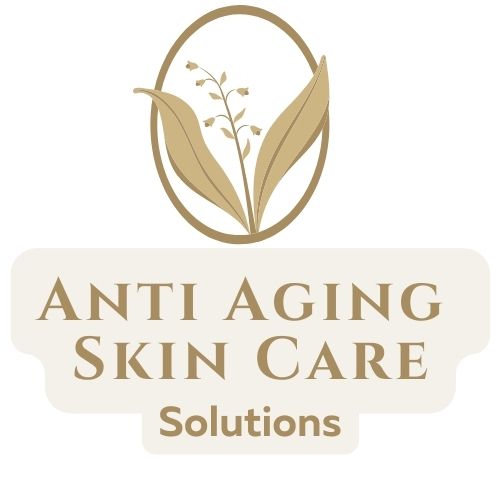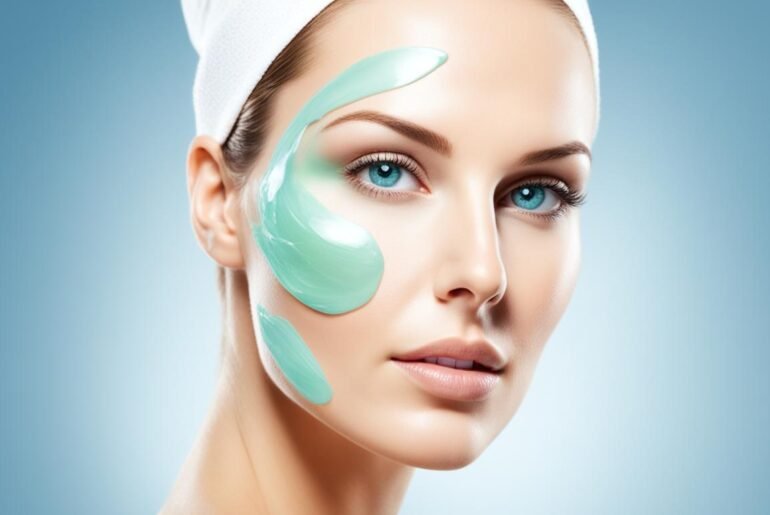
Did you know that the key to achieving youthful and radiant skin may be found in your skincare products? It’s true! Omega-3 fatty acids, commonly found in fish oil supplements and certain antiaging creams, offer incredible benefits for skin health. From regulating oil production to improving hydration and reducing signs of aging, omega-3 fatty acids can transform your complexion.
Key Takeaways:
- Omega-3 fatty acids can regulate oil production, improve hydration, and reduce breakouts.
- They strengthen the skin’s surface and barrier function, preventing moisture loss.
- Omega-3 fatty acids possess anti-inflammatory properties that soothe irritated and sensitive skin.
- Their inclusion in skincare products promotes healthier and more youthful-looking skin.
- Fish oil, flax seeds, chia seeds, and soybean oil are sources of omega-3 fatty acids.
What are Omega-3 Fatty Acids and their Types?
Omega-3 fatty acids are a type of polyunsaturated fatty acids that are vital for our body’s functioning. These essential fats play a crucial role in maintaining overall health and well-being. There are three main types of omega-3 fatty acids that are commonly found in our diet:
- Alpha-linolenic acid (ALA) – Alpha-linolenic acid is a plant-based omega-3 fatty acid. It is predominantly found in flaxseeds, chia seeds, and walnuts. Our body can convert ALA into other forms of omega-3 fatty acids, such as EPA and DHA, but the conversion rate is limited.
- Eicosapentaenoic acid (EPA) – EPA is primarily found in fatty fish, such as salmon, mackerel, and sardines. It is highly beneficial for heart health and reducing inflammation in the body.
- Docosahexaenoic acid (DHA) – DHA is another omega-3 fatty acid found in fatty fish. It is particularly important for brain health and development, as well as supporting eye health.
These omega-3 fatty acids are essential components of cell membranes and contribute to various health benefits. Omega-3s have been extensively studied for their anti-inflammatory properties, heart health benefits, and support for brain function.
Benefits of Omega-3 Fatty Acids:
“Omega-3 fatty acids offer a wide range of health benefits, including reducing inflammation, supporting brain function, and promoting heart health.”
Research has shown that omega-3 fatty acids can help reduce inflammation in the body and may alleviate symptoms of chronic inflammatory conditions such as arthritis. They also support optimal brain function and are crucial for brain development in infants and children.
Moreover, omega-3 fatty acids play a significant role in heart health. They have been found to lower triglyceride levels, reduce blood pressure, and help prevent the formation of blood clots. Regular omega-3 consumption has also been associated with a reduced risk of heart disease and stroke.
Incorporating omega-3 fatty acids into your diet can provide numerous health benefits. Whether through fish oil supplements or consuming omega-3-rich foods, such as fatty fish, flaxseeds, and chia seeds, it’s essential to ensure an adequate intake of these beneficial fats.
Comparison of Omega-3 Fatty Acids:
To better understand the differences between the three main types of omega-3 fatty acids, here is a comparison:
| Type of Omega-3 | Sources | Health Benefits |
|---|---|---|
| Alpha-linolenic acid (ALA) | Flaxseeds, Chia seeds, Walnuts | – Supports heart health – Helps reduce inflammation – May improve mood and skin health |
| Eicosapentaenoic acid (EPA) | Fatty fish (Salmon, Mackerel, Sardines) | – Promotes heart health – Reduces inflammation – Supports brain function |
| Docosahexaenoic acid (DHA) | Fatty fish (Salmon, Mackerel, Sardines) | – Vital for brain health and development – Supports eye health – Reduces inflammation |
While ALA is predominantly found in plant sources, EPA and DHA are mainly derived from fatty fish. Although our body can convert ALA into EPA and DHA to some extent, it is more efficient to obtain EPA and DHA directly from fish or fish oil supplements for optimal health benefits.
How Omega-3 Fatty Acids Benefit the Skin

Omega-3 fatty acids are not only beneficial for our overall health but also play a crucial role in maintaining the health and appearance of our skin. These essential fatty acids offer a range of skin benefits, including hydration, strengthening the skin’s barrier function, and reducing inflammation.
Promoting Skin Hydration
One of the key benefits of omega-3 fatty acids for the skin is their ability to promote hydration. These fatty acids help to prevent moisture loss from the skin, keeping it well-hydrated and supple. By improving the skin’s moisture levels, omega-3 fatty acids can contribute to a more radiant and youthful complexion.
Strengthening the Skin Barrier Function
A strong and healthy skin barrier is vital for maintaining optimal skin health. Omega-3 fatty acids play a crucial role in strengthening the skin’s barrier function, which acts as a protective shield against environmental aggressors and moisture loss. By enhancing the skin barrier, omega-3 fatty acids help to lock in moisture and keep the skin hydrated.
Reducing Inflammation
“Omega-3 fatty acids possess anti-inflammatory properties that can soothe irritated and sensitive skin.”
Inflammation is a common skin concern that can lead to various skin issues. Omega-3 fatty acids possess anti-inflammatory properties, which can effectively calm and soothe irritated and sensitive skin. By reducing inflammation, these fatty acids can alleviate redness, itching, and discomfort, promoting a more balanced and comfortable complexion.
Enhancing Natural Defense Against UV Damage
The damaging effects of UV radiation on the skin are well-known. Omega-3 fatty acids have been found to enhance the skin’s natural defense against UV damage. They help to strengthen the skin’s protective barrier, protecting it from harmful UV rays. Additionally, omega-3 fatty acids have been shown to have photoprotective properties, reducing the risk of sunburn and other sun-related skin damage.
By incorporating omega-3 fatty acids into your skincare routine, you can enjoy the numerous benefits they offer for your skin. From promoting hydration and strengthening the skin’s barrier function to reducing inflammation and enhancing natural defense against UV damage, omega-3 fatty acids play a vital role in maintaining healthy, radiant, and youthful-looking skin.
Sources of Omega-3 Fatty Acids
Omega-3 fatty acids are essential for our overall health, and incorporating them into our diet is a great way to reap their benefits. There are various food sources that provide these valuable fatty acids, including fish oil, flax seeds, chia seeds, and soybean oil.
Fish Oil
One of the richest sources of omega-3 fatty acids is fish oil, which is derived from fatty fish such as salmon, trout, and mackerel. These fish are not only delicious but also packed with the beneficial EPA and DHA types of omega-3 fatty acids. Fish oil is easily absorbed by the body, making it an efficient way to increase your omega-3 intake.
Flax Seeds
For those following a vegetarian or vegan diet, flax seeds are an excellent source of omega-3 fatty acids. These tiny seeds contain high levels of alpha-linolenic acid (ALA), a plant-based omega-3 fatty acid. Including ground flax seeds in your meals or adding them to smoothies can help boost your omega-3 intake.
Chia Seeds
Similar to flax seeds, chia seeds are a fantastic plant-based source of omega-3 fatty acids. They are rich in ALA and provide a range of health benefits. Adding chia seeds to your breakfast cereal, yogurt, or baked goods can enhance the nutritional value of your meals.
Soybean Oil
Soybean oil is another plant-based option for obtaining omega-3 fatty acids. It contains a good amount of ALA and can be used in cooking, salad dressings, or as a cooking oil substitute. Incorporating soybean oil into your diet can contribute to your daily omega-3 intake.
The Benefits of Omega-3 Fatty Acids
Omega-3 fatty acids offer numerous health benefits, including improved cardiovascular health, brain function, and reduced inflammation. These essential fats are particularly beneficial for skin health, as they promote hydration, strengthen the skin’s barrier function, and help reduce signs of aging.
While fish oil is a direct source of EPA and DHA, plant-based sources such as flax seeds, chia seeds, and soybean oil need to be converted by the body before they can be utilized effectively. However, including a variety of omega-3-rich foods in your diet can ensure a steady supply of these valuable fatty acids.
| Food Source | Type of Omega-3 |
|---|---|
| Fish Oil | EPA, DHA |
| Flax Seeds | ALA |
| Chia Seeds | ALA |
| Soybean Oil | ALA |
Incorporating Omega-3 Fatty Acids into Skincare Routine

When it comes to skincare, incorporating omega-3 fatty acids into your routine can provide numerous benefits. Whether through topical application or using skincare products rich in omega-3, you can harness the power of these essential fatty acids for healthier and more nourished skin.
To introduce omega-3 fatty acids into your skincare routine, look for products specifically formulated to contain these beneficial compounds. Opt for skincare products that directly incorporate omega-3 fatty acids or those that utilize plant-based oils known for their omega-3 content. The following plant-based oils are rich in omega-3 and can be used as moisturizers or applied on top of your regular moisturizer:
- Safflower oil
- Sunflower oil
- Rosehip oil
- Blackcurrant seed oil
These oils not only provide hydration but also deliver the nourishing benefits of omega-3 fatty acids to your skin. Their lightweight and non-greasy textures make them suitable for all skin types.
By incorporating omega-3 fatty acids into your skincare routine, you can enhance your skin’s moisture levels, improve its barrier function, and nourish it with essential nutrients. Whether you choose to use skincare products containing omega-3 directly or opt for plant-based oils, the result will be healthier, more radiant skin.
Remember, consistency is key when it comes to skincare. Use omega-3 products regularly and follow a dedicated skincare routine to maximize the benefits. With this simple addition, you can take your skincare routine to the next level and achieve the beautiful, glowing skin you desire.
| Skincare Product | Description |
|---|---|
| Paula’s Choice RESIST Omega+ Complex Serum | A serum containing omega-3, -6, and -9 fatty acids to nourish and hydrate the skin. |
| Ren Vita Mineral Omega 3 Optimum Skin Oil | An oil enriched with omega-3 fatty acids to improve skin elasticity and radiance. |
| True Botanicals Pure Radiance Oil | A multi-purpose oil that combines omega-3 fatty acids with other botanical extracts for a revitalized complexion. |
| Biossance Squalane + Omega Repair Cream | A nourishing cream infused with omega-3 fatty acids and squalane to repair and moisturize the skin. |
| Farmacy Honey Grail Ultra-Hydrating Face Oil | A luxurious face oil formulated with omega-3-rich honey and other botanical oils for intense hydration. |
Recommended Antiaging Creams with Omega-3
When it comes to antiaging skincare, incorporating omega-3 fatty acids into your routine can provide exceptional benefits. Omega-3 fatty acids help strengthen the skin’s surface and promote hydration, resulting in a more youthful and radiant complexion. To assist you in finding the best omega-3-infused products, here are some highly recommended antiaging creams:
- Paula’s Choice RESIST Omega+ Complex Serum: This serum is formulated with a potent blend of omega-3, -6, and -9 fatty acids to nourish and rejuvenate the skin. Its lightweight formula absorbs quickly, delivering essential nutrients for a smooth and supple complexion.
- Ren Vita Mineral Omega 3 Optimum Skin Oil: A luxurious face oil infused with omega-3 fatty acids, it replenishes moisture and promotes elasticity, helping to minimize the appearance of fine lines and wrinkles. This oil is a great addition to any skincare routine, leaving your skin looking radiant and revitalized.
- True Botanicals Pure Radiance Oil: This omega-rich face oil contains a blend of nourishing oils, including omega-3 fatty acids, to deeply hydrate and restore the skin’s natural radiance. It absorbs quickly and provides long-lasting moisture, leaving your skin smooth and plump.
- Biossance Squalane + Omega Repair Cream: Formulated with squalane and omega fatty acids, this cream helps strengthen the skin’s moisture barrier and improves elasticity. It also visibly reduces the appearance of fine lines and wrinkles, giving you a more youthful complexion.
- Farmacy Honey Grail Ultra-Hydrating Face Oil: Infused with omega-3 fatty acids and antioxidant-rich honey, this face oil delivers deep hydration and nourishment. It helps to replenish dry and dull skin, leaving it soft, supple, and radiant.
These recommended antiaging creams with omega-3 fatty acids offer a range of benefits for your skin. Whether you prefer a serum, face oil, or cream, incorporating these products into your skincare routine can help improve hydration, reduce the signs of aging, and promote a more youthful appearance. Choose the product that aligns with your skin’s needs and experience the transformative power of omega-3 fatty acids.
Benefits of Topical Omega-3 Fatty Acids

Topical application of omega-3 fatty acids provides numerous benefits for the skin. By incorporating omega-3 fatty acids into your skincare routine, you can experience improved skin hydration, enhanced barrier function, and reduced inflammation.
“Topical omega-3 fatty acids can be a game-changer for your skincare routine. These powerful nutrients have been shown to improve the skin’s overall health and appearance.”
One of the top benefits of topical omega-3 fatty acids is skin hydration. These fatty acids help prevent moisture loss, keeping the skin well-hydrated and nourished. This can result in a plumper, smoother complexion and a more youthful appearance.
In addition to hydration, topical omega-3 fatty acids can improve the skin’s barrier function. The skin’s barrier acts as a protective shield, preventing irritants and pollutants from penetrating the skin. Omega-3 fatty acids help strengthen this barrier, making it more resilient and effective in keeping harmful elements out.
Another significant benefit of topical omega-3 fatty acids is their anti-inflammatory properties. Inflammation can cause redness, irritation, and discomfort in the skin. Omega-3 fatty acids work to reduce inflammation, providing relief to sensitive and inflamed skin. This can be particularly beneficial for those with conditions such as acne, rosacea, or eczema.
Overall, incorporating topical omega-3 fatty acids into your skincare routine can lead to a healthier complexion and reduced signs of aging. The hydrating, barrier-improving, and anti-inflammatory effects of omega-3 fatty acids contribute to a more radiant and youthful-looking skin.
| Benefits of Topical Omega-3 Fatty Acids |
|---|
| Improved skin hydration |
| Enhanced barrier function |
| Reduced inflammation |
Recommended Daily Intake of Omega-3 Fatty Acids

When it comes to the daily intake of omega-3 fatty acids, there is no one-size-fits-all recommendation. However, health experts suggest that adults should aim for a daily dosage of approximately 500 mg, which can be achieved through consuming two servings of fatty fish per week. This dosage not only provides overall health benefits but also contributes to supple and radiant skin.
Fatty fish, such as salmon, trout, and sardines, are excellent sources of omega-3 fatty acids. These fish contain high amounts of eicosapentaenoic acid (EPA) and docosahexaenoic acid (DHA), two essential omega-3 fatty acids that offer numerous health advantages.
The Benefits of a Daily Intake of Omega-3 Fatty Acids
Regular consumption of omega-3 fatty acids has been linked to various health benefits, including:
- Promoting heart health and reducing the risk of cardiovascular diseases
- Supporting brain function and cognitive development
- Reducing inflammation in the body
- Supporting proper eye health and vision
In terms of skincare, omega-3 fatty acids can contribute to improved skin health, hydration, and a reduction in signs of aging. By incorporating omega-3 fatty acids into your daily routine, you can support overall well-being while enhancing the appearance and vitality of your skin.
If your diet does not provide enough omega-3 fatty acids, supplementing with fish oil capsules can be a convenient option. Fish oil capsules are a concentrated source of EPA and DHA, making it easier to meet the recommended daily intake.
When choosing fish oil supplements, opt for reputable brands that ensure purity and quality. Look for products that have undergone third-party testing and are certified free of heavy metals, toxins, and contaminants.
| Fish | EPA Content (mg per 100g) | DHA Content (mg per 100g) |
|---|---|---|
| Salmon | 660 | 990 |
| Mackerel | 570 | 1,080 |
| Sardines | 520 | 1,020 |
| Tuna | 380 | 830 |
Did You Know? Including a variety of fish in your diet can provide a wider range of omega-3 fatty acids, as different species contain varying levels of EPA and DHA.
Remember, it’s always best to consult with a healthcare professional before making any significant changes to your diet or incorporating supplements.
Myths and Misconceptions About Omega-3 Fatty Acids
There are some common myths and misconceptions surrounding omega-3 fatty acids. Let’s debunk them to ensure accurate information about this essential nutrient.
Myth: Fish is the Only Source of Omega-3
Contrary to popular belief, fish is not the only source of omega-3 fatty acids. While fatty fish like salmon and trout are indeed rich in omega-3, there are other alternatives for those who follow a vegetarian or vegan diet.
Plant sources of omega-3, such as flax seeds, chia seeds, and soybean oil, also contain these beneficial fatty acids. However, it’s important to note that plant sources may lack other components found in fish oil that provide the same comprehensive benefits.
Fact: Different Fish Contain Varying Levels of Omega-3
Not all fish are equal when it comes to omega-3 fatty acid content. Certain fish species, such as salmon, mackerel, and sardines, are known to be high in omega-3 fatty acids.
On the other hand, fish like tilapia and cod have lower levels of omega-3. To ensure an optimal intake of omega-3, it’s important to choose fatty fish varieties that are known for their high omega-3 content.
| Fatty Fish | Omega-3 Content (per 3.5 oz serving) |
|---|---|
| Salmon | 1.5-2.5 grams |
| Mackerel | 1.3-2.6 grams |
| Sardines | 1.1-1.7 grams |
| Tilapia | 0.1 gram |
| Cod | 0.1 gram |
“Not all fish are equal when it comes to omega-3 content. It’s important to choose fatty fish varieties known for their high omega-3 levels.”
Understanding these myths and facts will help you make informed choices about incorporating omega-3 fatty acids into your diet and skincare routine.
How to Incorporate Omega-3 Fatty Acids into Skincare Routine

When it comes to skincare, incorporating omega-3 fatty acids can be highly beneficial. To experience the advantages of these essential fatty acids, consider using serums and moisturizers specifically formulated with omega-3. One notable product that delivers these benefits directly to the skin is the Paula’s Choice RESIST Omega+ Complex Serum. With its targeted formulation, it enhances the appearance of your skin and supports its overall health.
You can also choose moisturizers that include omega-3 as an active ingredient, providing long-lasting hydration and nourishment. These moisturizers often work effectively as part of your daily skincare routine, ensuring your skin stays moisturized and supple throughout the day.
“By using serums and moisturizers infused with omega-3 fatty acids, you can unlock the potential benefits of this essential nutrient for your skin.”
By using serums and moisturizers infused with omega-3 fatty acids, you can unlock the potential benefits of this essential nutrient for your skin. Omega-3 helps strengthen the skin’s surface, improve hydration, reduce inflammation, and minimize signs of aging, leaving you with healthier, more radiant-looking skin.
Recommended Omega-3 Serums and Moisturizers
| Product | Description |
|---|---|
| Paula’s Choice RESIST Omega+ Complex Serum | A serum specifically formulated with omega-3, -6, and -9 fatty acids to nourish and restore the skin. |
| Ren Vita Mineral Omega 3 Optimum Skin Oil | An omega-3-rich skin oil that provides intense hydration and improves the skin’s overall appearance. |
| True Botanicals Pure Radiance Oil | A facial oil blend that combines omega-3 fatty acids with other botanical nutrients for radiant, healthier-looking skin. |
| Biossance Squalane + Omega Repair Cream | A moisturizing cream that contains omega-3 and squalane to hydrate and repair the skin’s natural barrier. |
| Farmacy Honey Grail Ultra-Hydrating Face Oil | An ultra-hydrating face oil enriched with omega-3 fatty acids and antioxidants to nourish and revitalize the skin. |
These serums and moisturizers are designed to give your skin the omega-3 fatty acids it needs to thrive. Incorporating these products into your daily skincare routine can improve the overall health and appearance of your skin, leaving it looking more youthful and vibrant.
Conclusion
Omega-3 fatty acids offer a multitude of benefits for skincare. By strengthening the skin’s surface, improving hydration, reducing inflammation, and minimizing signs of aging, omega-3 fatty acids can transform your skin. Incorporating these powerful acids into your skincare routine through the use of serums and moisturizers can promote healthier, more youthful-looking skin.
However, it’s not just about external application. Consuming omega-3 fatty acids through a balanced diet is equally important for overall skin and body health. By incorporating omega-3-rich foods into your meals, such as fatty fish like salmon, you can nourish your skin from the inside out.
With proper skincare and a focus on omega-3 fatty acids, you can unlock the secret to youthful skin. So, why wait? Start incorporating omega-3 fatty acids into your skincare routine and enjoy the numerous benefits they have to offer. Your skin will thank you.
FAQ
What are Omega-3 fatty acids and their types?
Omega-3 fatty acids are unsaturated fatty acids that are essential for our overall health. The three main types of Omega-3 fatty acids are alpha-linolenic acid (ALA), eicosapentaenoic acid (EPA), and docosahexaenoic acid (DHA).
How do Omega-3 fatty acids benefit the skin?
Omega-3 fatty acids help in strengthening the skin’s surface and barrier function, improving hydration, reducing inflammation, and minimizing signs of aging.
What are the sources of Omega-3 fatty acids?
Omega-3 fatty acids can be obtained through diet from various food sources such as fish oil (salmon, trout), flax seeds, chia seeds, and soybean oil.
How can I incorporate Omega-3 fatty acids into my skincare routine?
Omega-3 fatty acids can be incorporated into your skincare routine by using skincare products that contain Omega-3 directly or by using plant-based oils rich in Omega-3.
What are some recommended antiaging creams with Omega-3?
Some recommended antiaging creams with Omega-3 include Paula’s Choice RESIST Omega+ Complex Serum, Ren Vita Mineral Omega 3 Optimum Skin Oil, True Botanicals Pure Radiance Oil, Biossance Squalane + Omega Repair Cream, and Farmacy Honey Grail Ultra-Hydrating Face Oil.
What are the benefits of topical Omega-3 fatty acids?
Topical application of Omega-3 fatty acids provides benefits such as improved skin hydration, enhanced skin barrier function, and anti-inflammatory properties.
What is the recommended daily intake of Omega-3 fatty acids?
While there is no set recommended daily intake for Omega-3 fatty acids, health experts suggest that adults should aim for 500 mg per day, equivalent to two servings of fatty fish per week.
What are some myths and misconceptions about Omega-3 fatty acids?
One myth is that any fish is a good source of Omega-3, when in reality, different fish contain varying levels of these fatty acids. It is also important to note that plant sources of Omega-3 may lack other components that provide the same benefits as fish oil.
How can I incorporate Omega-3 fatty acids into my skincare routine?
You can incorporate Omega-3 fatty acids into your skincare routine by using serums and moisturizers that contain Omega-3 or by applying plant-based oils rich in Omega-3 as part of your skincare routine.



